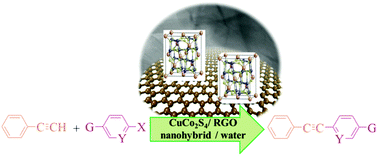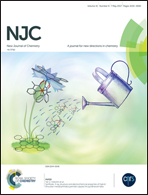Synthesis of thiospinel CuCo2S4 and CuCo2S4/reduced-graphene oxide nanohybrids as highly effective catalysts for the Sonogashira reaction†
Abstract
Formation of a carbon–carbon bond using the transition metal catalyzed Sonogashira coupling reaction is an indispensable tool in synthetic organic chemistry. Initially complexes of Pd were used as catalysts, however advances in catalyst design fuelled the development of Cu catalysts, which are cheaper and more environmentally benign than complexes of Pd. This is the first paper that reports the application of thiospinels in the Sonogashira reaction. Thiospinel CuCo2S4 and CuCo2S4/reduced-graphene oxide (RGO) nanohybrids were first synthesized through a simple solvothermal approach. Our studies show that all of these nanohybrids are suitable for the Sonogashira reaction in water at room temperature. Compared to classical reactions, this method consistently has the advantages of a green solvent, short reaction times, low catalyst loading, high yields and reusability of the catalysts and a facile method for the preparation of the catalysts. The CuCo2S4 and CuCo2S4/RGO nanohybrids showed highly improved catalytic activity towards aryl chloride derivatives compared to other catalysts that have been reported.


 Please wait while we load your content...
Please wait while we load your content...